Abstract
Cell extracts of Clostridium acidiurici, C. cylindrosporum, and C. purinolyticum converted purine, hypoxanthine, 2-hydroxypurine, 6,8-dihydroxypurine, and uric acid into xanthine by the shortest possible route. Adenine was transformed to xanthine only by C. purinolyticum, whereas the other two species formed 6-amino-8-hydroxypurine, which was neither deaminated nor hydroxylated further. 8-Hydroxypurine was formed from purine by all three species. Xanthine dehydrogenase activity was constitutively expressed by C. purinolyticum. Due to the lability of the enzyme activity, comparative studies could not be done with a purified preparation. All enzymes reported to be involved in formiminoglycine metabolism of C. acidiurici and C. cylindrosporum were present in C. purinolyticum. However, glycine was reduced directly to acetate in all three species, as indicated by radiochemical data and by the detection of glycine reductase in cell extracts of C. cylindrosporum and C. purinolyticum. The expression of glycine reductase and the high ratio of glycine fermented to uric acid present points to an energetic advantage for the glycine reductase system, which is expressed when selenium compounds are added to the growth media.
Full text
PDF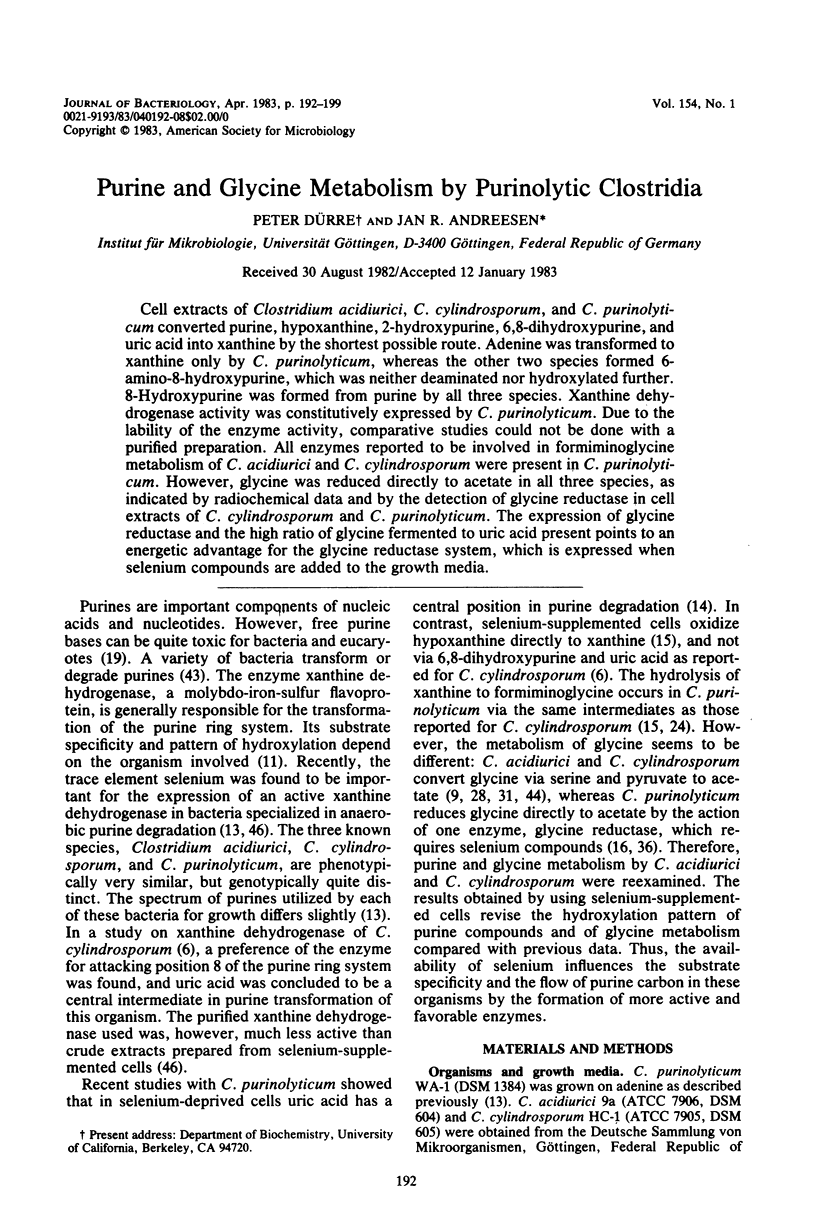
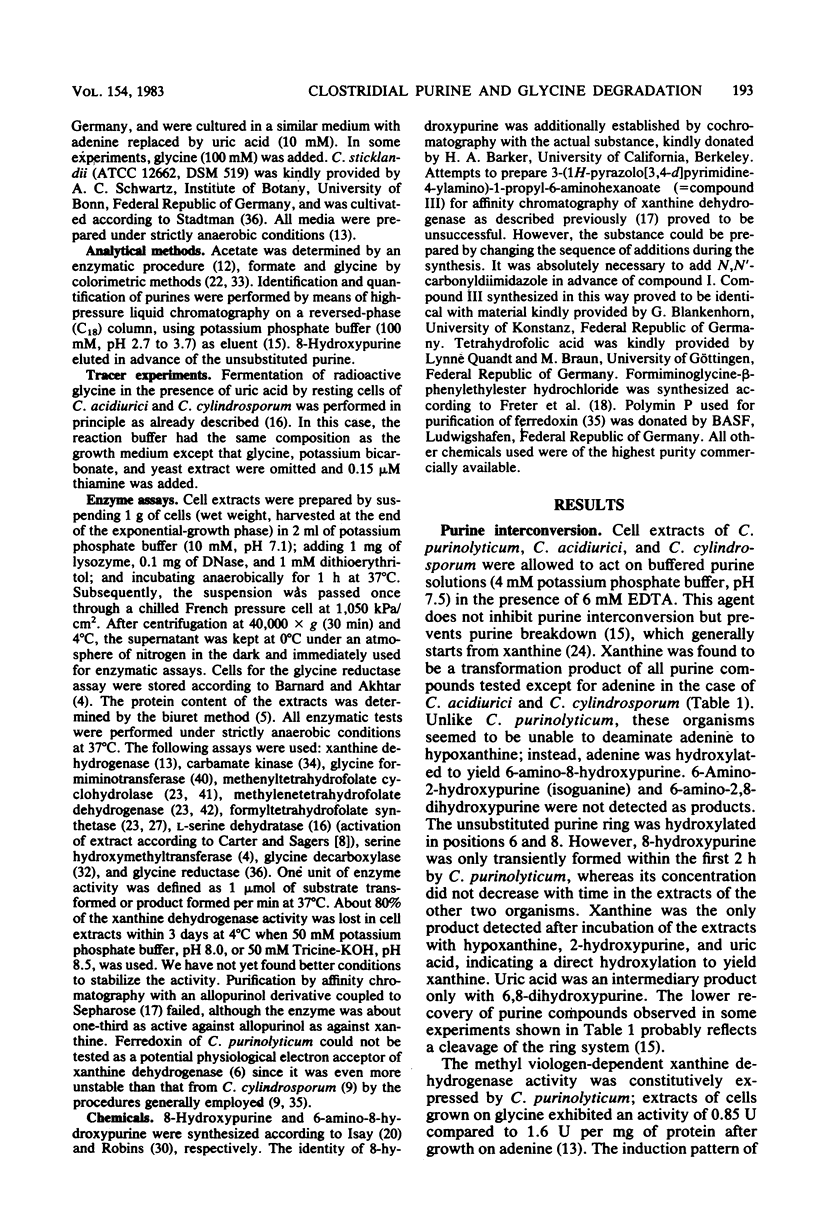
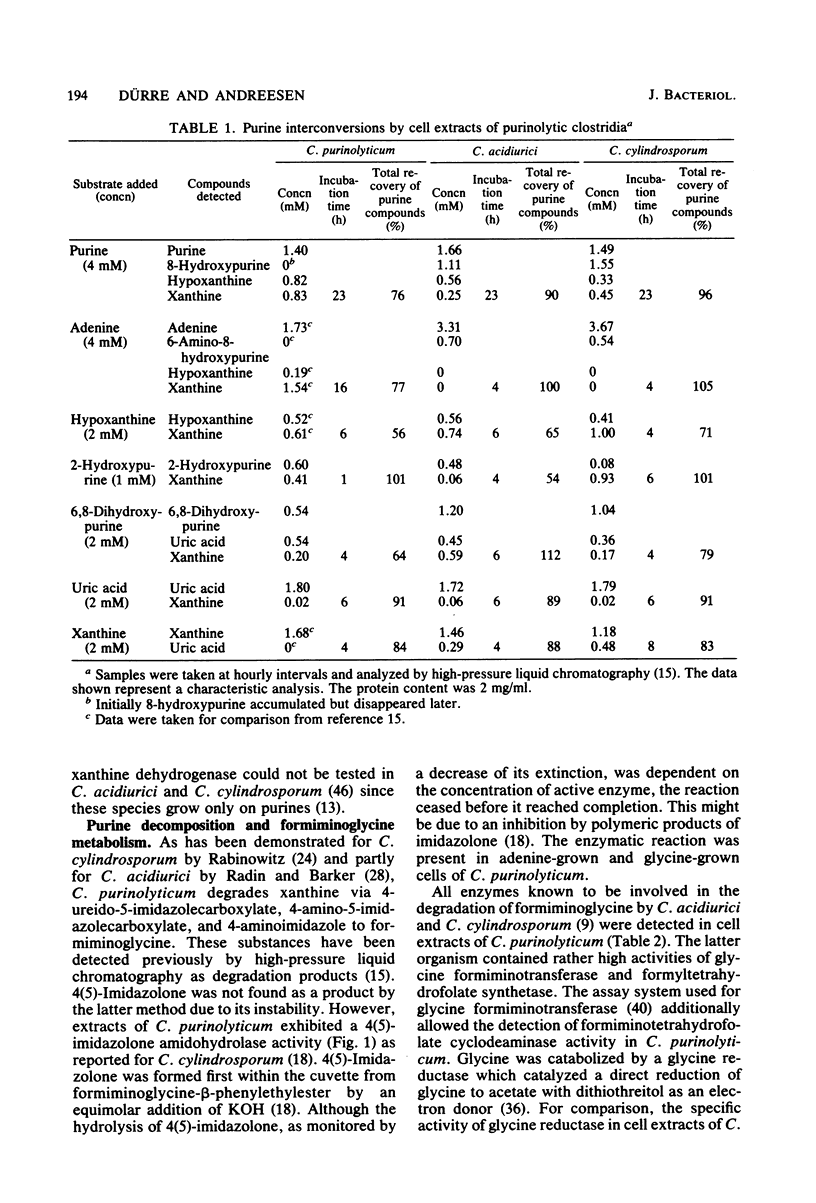
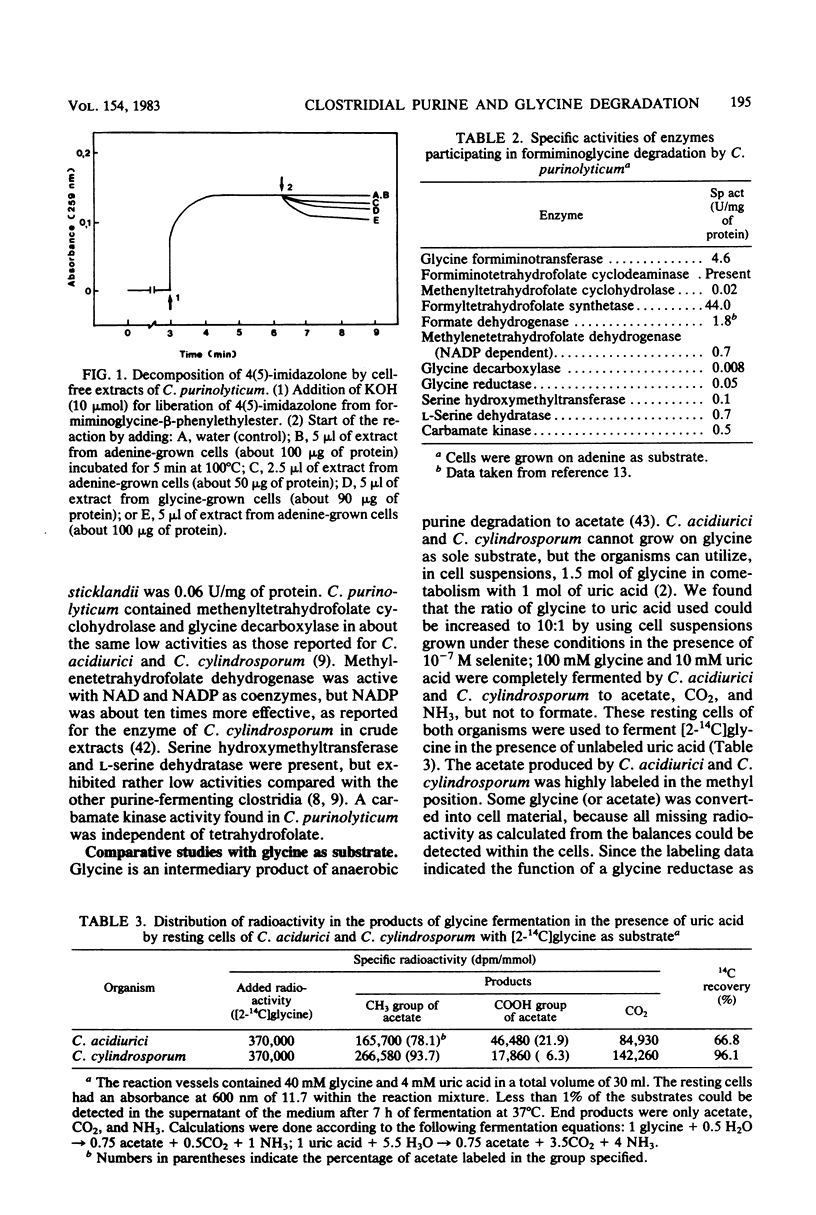
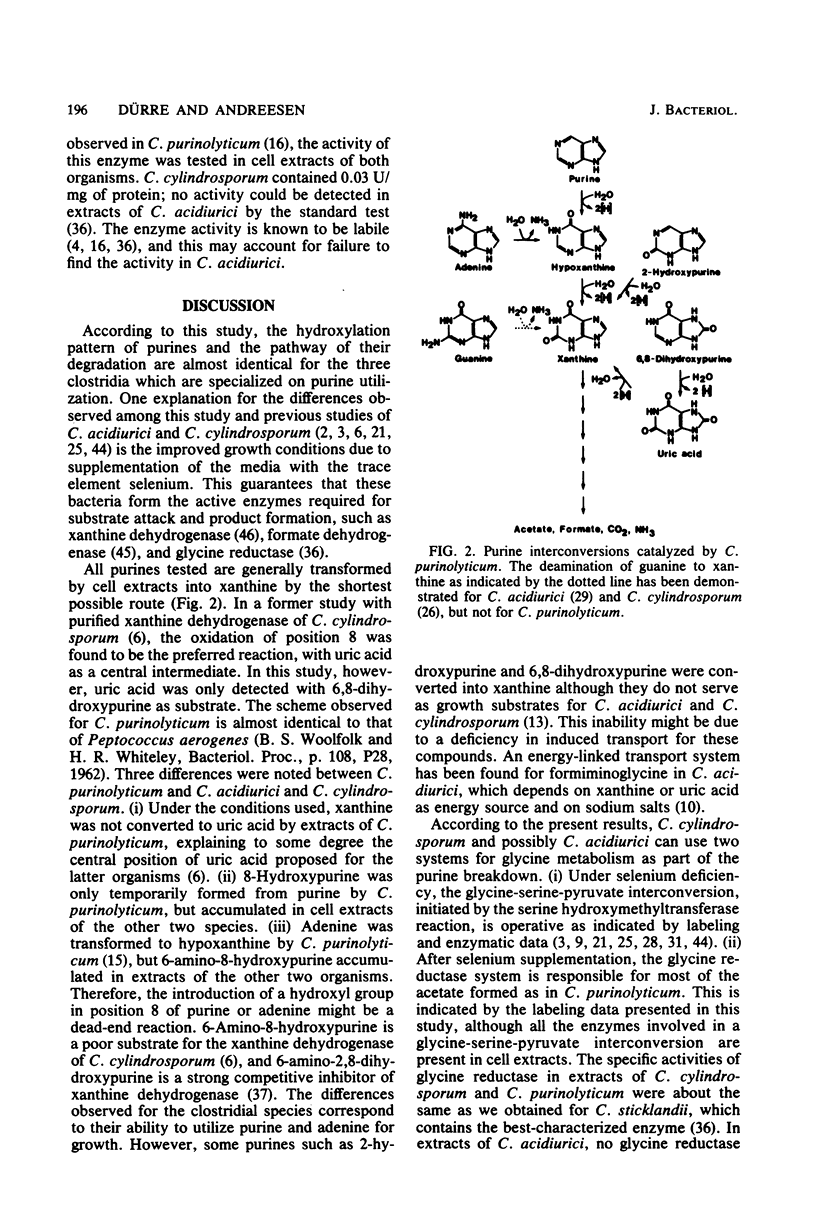

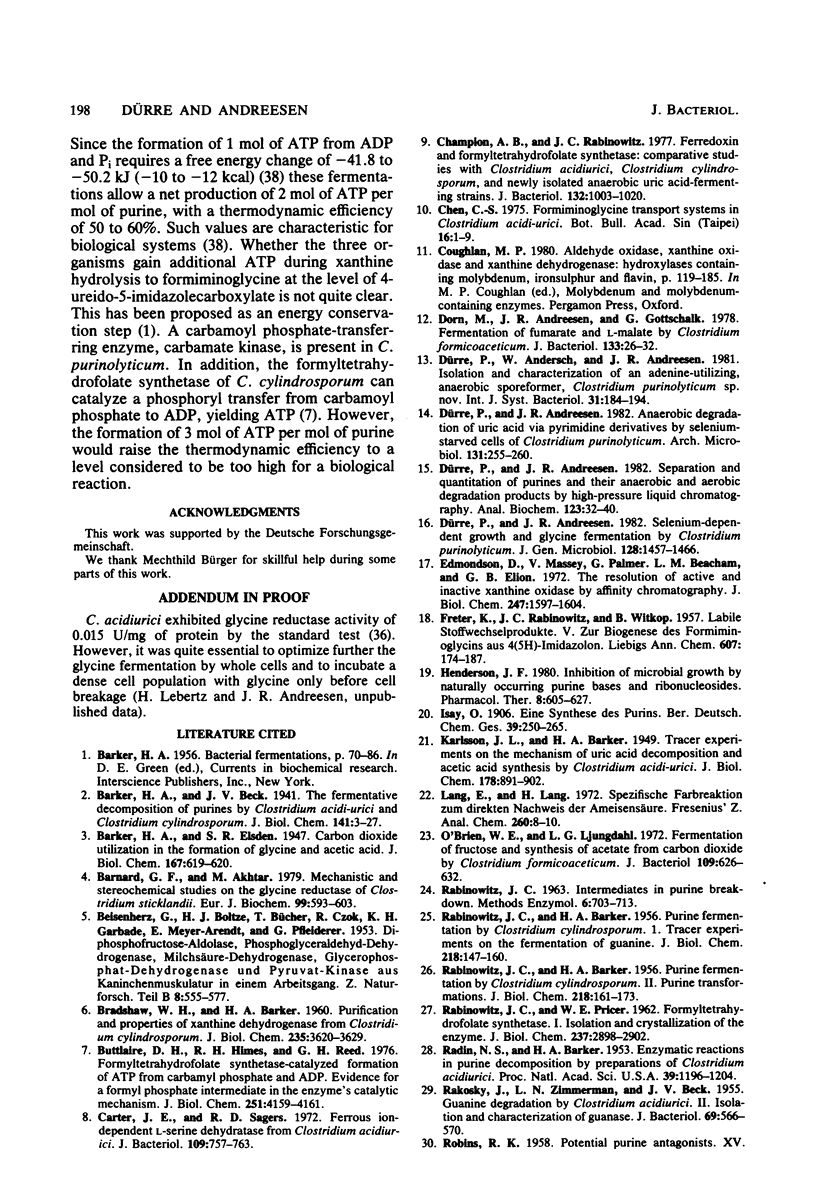
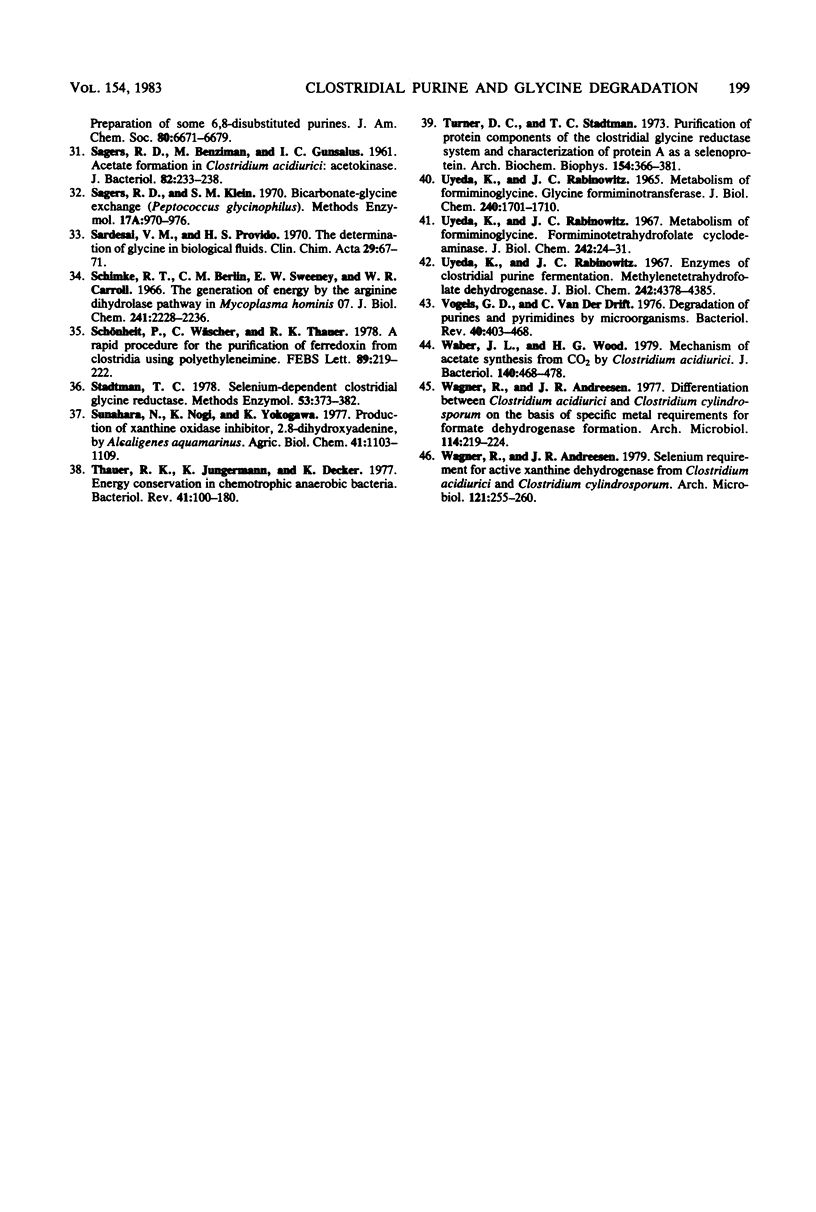
Selected References
These references are in PubMed. This may not be the complete list of references from this article.
- Barnard G. F., Akhtar M. Mechanistic and stereochemical studies on the glycine reductase of Clostridium sticklandii. Eur J Biochem. 1979 Sep;99(3):593–603. doi: 10.1111/j.1432-1033.1979.tb13292.x. [DOI] [PubMed] [Google Scholar]
- Buttlaire D. H., Himes R. H., Reed G. H. Formyltetrahydrofolate synthetase-catalyzed formation of ATP from carbamyl phosphate and ADP. Evidence for a formyl phosphate intermediate in the enzyme's catalytic mechanism. J Biol Chem. 1976 Jul 10;251(13):4159–4161. [PubMed] [Google Scholar]
- Carter J. E., Sagers R. D. Ferrous ion-dependent L-serine dehydratase from Clostridium acidiurici. J Bacteriol. 1972 Feb;109(2):757–763. doi: 10.1128/jb.109.2.757-763.1972. [DOI] [PMC free article] [PubMed] [Google Scholar]
- Champion A. B., Rabinowitz J. C. Ferredoxin and formyltetrahydrofolate synthetase: comparative studies with Clostridium acidiurici, Clostridium cylindrosporum, and newly isolated anaerobic uric acid-fermenting strains. J Bacteriol. 1977 Dec;132(3):1003–1020. doi: 10.1128/jb.132.3.1003-1020.1977. [DOI] [PMC free article] [PubMed] [Google Scholar]
- Dorn M., Andreesen J. R., Gottschalk G. Fermentation of fumarate and L-malate by Clostridium formicoaceticum. J Bacteriol. 1978 Jan;133(1):26–32. doi: 10.1128/jb.133.1.26-32.1978. [DOI] [PMC free article] [PubMed] [Google Scholar]
- Dürre P., Andreesen J. P. Separation and quantitation of purines and their anaerobic and aerobic degradation products by high-pressure liquid chromatography. Anal Biochem. 1982 Jun;123(1):32–40. doi: 10.1016/0003-2697(82)90619-4. [DOI] [PubMed] [Google Scholar]
- Dürre P., Andreesen J. R. Anaerobic degradation of uric acid via pyrimidine derivatives by selenium-starved cells of Clostridium purinolyticum. Arch Microbiol. 1982 May;131(3):255–260. doi: 10.1007/BF00405889. [DOI] [PubMed] [Google Scholar]
- Dürre P., Andreesen J. R. Selenium-dependent growth and glycine fermentation by Clostridium purinolyticum. J Gen Microbiol. 1982 Jul;128(7):1457–1466. doi: 10.1099/00221287-128-7-1457. [DOI] [PubMed] [Google Scholar]
- Edmondson D., Massey V., Palmer G., Beacham L. M., 3rd, Elion G. B. The resolution of active and inactive xanthine oxidase by affinity chromatography. J Biol Chem. 1972 Mar 10;247(5):1597–1604. [PubMed] [Google Scholar]
- Henderson J. F. Inhibition of microbial growth by naturally-occurring purine bases and ribonucleosides. Pharmacol Ther. 1980;8(3):605–627. doi: 10.1016/0163-7258(80)90078-9. [DOI] [PubMed] [Google Scholar]
- O'Brien W. E., Ljungdahl L. G. Fermentation of fructose and synthesis of acetate from carbon dioxide by Clostridium formicoaceticum. J Bacteriol. 1972 Feb;109(2):626–632. doi: 10.1128/jb.109.2.626-632.1972. [DOI] [PMC free article] [PubMed] [Google Scholar]
- RABINOWITZ J. C., BARKER H. A. Purine fermentation by Clostridium cylindrosporum. I. Tracer experiments on the fermentation of guanine. J Biol Chem. 1956 Jan;218(1):147–160. [PubMed] [Google Scholar]
- RABINOWITZ J. C., BARKER H. A. Purine fermentation by Clostridium cylindrosporum. II. Purine transformations. J Biol Chem. 1956 Jan;218(1):161–173. [PubMed] [Google Scholar]
- RABINOWITZ J. C., PRICER W. E., Jr Formyltetrahydrofolate synthetase. I. Isolation and crystallization of the enzyme. J Biol Chem. 1962 Sep;237:2898–2902. [PubMed] [Google Scholar]
- RAKOSKY J., Jr, ZIMMERMAN L. N., BECK J. V. Guanine degradation by Clostridium acidiurici. II. Isolation and characterization of guanase. J Bacteriol. 1955 May;69(5):566–570. doi: 10.1128/jb.69.5.566-570.1955. [DOI] [PMC free article] [PubMed] [Google Scholar]
- Radin N. S., Barker H. A. Enzymatic Reactions in Purine Decomposition by Preparations of Clostridium Acidi-Urici. Proc Natl Acad Sci U S A. 1953 Dec;39(12):1196–1204. doi: 10.1073/pnas.39.12.1196. [DOI] [PMC free article] [PubMed] [Google Scholar]
- SAGERS R. D., BENZIMAN M., GUNSALUS I. C. Acetate formation in Clostridium acidi-urici: acetokinase. J Bacteriol. 1961 Aug;82:233–238. doi: 10.1002/path.1700820136. [DOI] [PMC free article] [PubMed] [Google Scholar]
- Sardesai V. M., Provido H. S. The determination of glycine in biological fluids. Clin Chim Acta. 1970 Jul;29(1):67–71. doi: 10.1016/0009-8981(70)90222-6. [DOI] [PubMed] [Google Scholar]
- Schimke R. T., Berlin C. M., Sweeney E. W., Carroll W. R. The generation of energy by the arginine dihydrolase pathway in Mycoplasma hominis 07. J Biol Chem. 1966 May 25;241(10):2228–2236. [PubMed] [Google Scholar]
- Schönheit P., Wäscher C., Thauer R. K. A rapid procedure for the purification of ferredoxin from Clostridia using polyethyleneimine. FEBS Lett. 1978 May 15;89(2):219–222. doi: 10.1016/0014-5793(78)80221-x. [DOI] [PubMed] [Google Scholar]
- Stadtman T. C. Selenium-dependent clostridial glycine reductase. Methods Enzymol. 1978;53:373–382. doi: 10.1016/s0076-6879(78)53043-7. [DOI] [PubMed] [Google Scholar]
- Thauer R. K., Jungermann K., Decker K. Energy conservation in chemotrophic anaerobic bacteria. Bacteriol Rev. 1977 Mar;41(1):100–180. doi: 10.1128/br.41.1.100-180.1977. [DOI] [PMC free article] [PubMed] [Google Scholar]
- Turner D. C., Stadtman T. C. Purification of protein components of the clostridial glycine reductase system and characterization of protein A as a selenoprotein. Arch Biochem Biophys. 1973 Jan;154(1):366–381. doi: 10.1016/0003-9861(73)90069-6. [DOI] [PubMed] [Google Scholar]
- UYEDA K., RABINOWITZ J. C. METABOLISM OF FORMIMINOGLYCINE. GLYCINE FORMIMINOTRANSFERASE. J Biol Chem. 1965 Apr;240:1701–1710. [PubMed] [Google Scholar]
- Uyeda K., Rabinowitz J. C. Enzymes of clostridial purine fermentation. Methylenetetrahydrofolate dehydrogenase. J Biol Chem. 1967 Oct 10;242(19):4378–4385. [PubMed] [Google Scholar]
- Uyeda K., Rabinowitz J. C. Metabolism of formiminoglycine. Formiminotetrahydrofolate cyclodeaminase. J Biol Chem. 1967 Jan 10;242(1):24–31. [PubMed] [Google Scholar]
- Vogels G. D., Van der Drift C. Degradation of purines and pyrimidines by microorganisms. Bacteriol Rev. 1976 Jun;40(2):403–468. doi: 10.1128/br.40.2.403-468.1976. [DOI] [PMC free article] [PubMed] [Google Scholar]
- Wagner R., Andreesen J. R. Differentiation between Clostridium acidiurici and Clostridium cylindrosporum on the basis of specific metal requirements for formate dehydrogenase formation. Arch Microbiol. 1977 Sep 28;114(3):219–224. doi: 10.1007/BF00446865. [DOI] [PubMed] [Google Scholar]
- Wagner R., Andreesen J. R. Selenium requirement for active xanthine dehydrogenase from Clostridium acidiurici and Clostridium cylindrosporum. Arch Microbiol. 1979 Jun;121(3):255–260. doi: 10.1007/BF00425064. [DOI] [PubMed] [Google Scholar]


